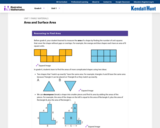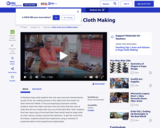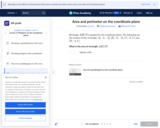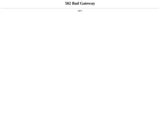
Family facing 6th Grade math unit focusing on area and surface area.
- Subject:
- Geometry
- Mathematics
- Material Type:
- Unit of Study
- Provider:
- Illustrative Mathematics
- Date Added:
- 11/17/2020

Family facing 6th Grade math unit focusing on area and surface area.

In this unit, students learn to find areas of polygons by decomposing, rearranging, and composing shapes. They learn to understand and use the terms “base” and “height,” and find areas of parallelograms and triangles. Students approximate areas of non-polygonal regions by polygonal regions. They represent polyhedra with nets and find their surface areas.

Student facing 6th Grade math unit focusing on area and surface area.

Convert metric measurements to U.S. Measurements and the reverse, too. Easy to follow tables have sections for area, length, mass,temperature and volume.

Students develop an understanding of areas as how much two-dimensional space a figure takes up, and relate it to their work with multiplication from Units 2 and 3.

Student-made monsters on grid paper are a great way to stimulate comparison problem-solving.

Use Pi (3.14) to find the area and circumference of a circle.

Video lesson explores how to find the length and width of a rectangular table given the perimeter and area. [4:45]
Khan Academy learning modules include a Community space where users can ask questions and seek help from community members. Educators should consult with their Technology administrators to determine the use of Khan Academy learning modules in their classroom. Please review materials from external sites before sharing with students.

A Hawaiian kapa artist explains how she uses area and measurements as part of her art-making process in this video from the Center for Asian American Media. In the accompanying classroom activity, students watch the video and learn how the artist finds the area of cloth that she can create with one cup of tree bark fiber. Next, students find how many cups of tree bark fiber they would need for kapa cloth to cover various surfaces around the classroom. To get the most from this lesson, students should have experience using a constant of proportionality to find proportional relationships.

Find the area and perimeter of quadrilaterals using their coordinates. Students receive immediate feedback and have the opportunity to try questions repeatedly, watch a video or receive hints.
Khan Academy learning modules include a Community space where users can ask questions and seek help from community members. Educators should consult with their Technology administrators to determine the use of Khan Academy learning modules in their classroom. Please review materials from external sites before sharing with students.

This short video and interactive assessment activity is designed to teach third graders about area in grid.

Practice finding the areas of complex shapes that are composed of smaller shapes. Students receive immediate feedback and have the opportunity to try questions repeatedly, watch a video or receive hints.
Khan Academy learning modules include a Community space where users can ask questions and seek help from community members. Educators should consult with their Technology administrators to determine the use of Khan Academy learning modules in their classroom. Please review materials from external sites before sharing with students.

Models how to break an irregular polygon into smaller composite shapes, calculate the area for each of those, then add all the amounts together to get the total area. [5:15]
Khan Academy learning modules include a Community space where users can ask questions and seek help from community members. Educators should consult with their Technology administrators to determine the use of Khan Academy learning modules in their classroom. Please review materials from external sites before sharing with students.

This short video and interactive assessment activity is designed to teach third graders an overview of area of squares and rectangles - word problems.

Practice finding the areas of trapezoids. Students receive immediate feedback and have the opportunity to try questions repeatedly, watch a video or receive hints.
Khan Academy learning modules include a Community space where users can ask questions and seek help from community members. Educators should consult with their Technology administrators to determine the use of Khan Academy learning modules in their classroom. Please review materials from external sites before sharing with students.

Video tutorial demonstrates how to find the area of a trapezoid using the formula A=(a+b)/2 x h. [4:47]
Khan Academy learning modules include a Community space where users can ask questions and seek help from community members. Educators should consult with their Technology administrators to determine the use of Khan Academy learning modules in their classroom. Please review materials from external sites before sharing with students.

Learn the formula for the area of a triangle, one half base times height. [5:29]
Khan Academy learning modules include a Community space where users can ask questions and seek help from community members. Educators should consult with their Technology administrators to determine the use of Khan Academy learning modules in their classroom. Please review materials from external sites before sharing with students.

Models how to calculate the area of a circle when the diameter is known. [4:02]
Khan Academy learning modules include a Community space where users can ask questions and seek help from community members. Educators should consult with their Technology administrators to determine the use of Khan Academy learning modules in their classroom. Please review materials from external sites before sharing with students.

In this video tutorial lesson, determine the area of a parallelogram using triangles and rectangles then assess learning with a quiz. [3:34]

In this video, students will determine the area of a trapezoid and assess learning with a quiz. [4:24]